Abstract
OBJECTIVE--To study the prevalence of infertility, both primary and secondary, outcome of pregnancy, occupation, and uptake of medical services in a total population of women from a geographically defined area. DESIGN--A postal questionnaire survey of an age cohort of women who had completed their fertility, and who were randomly selected from the Grampian Health Board's primary care register. SETTING--Aberdeen city district. SUBJECTS--1024 Women in the age group 46-50, of whom 130 had to be excluded. Of the remaining 894 women, 766 (86%) responded to the questionnaire. MAIN OUTCOME MEASURES--Response to questionnaire on pregnancy history, the length of time taken to become pregnant each time, and whether medical advice had been sought. RESULTS--Among the 766 women contacted, 602 (79%) reported no difficulties in having children, 56 (7%) had chosen not to have children, and the remaining 108 (14%) had experienced infertility, defined as having difficulty in becoming pregnant for more than two years. In total 68 (9%) women had primary infertility, of whom 41 (5%) eventually conceived. Of the 40 (5%) with secondary infertility, 23 (3%) conceived. Overall, 52 (7%) of the population were left with an unresolved problem of infertility. Only 67 (62%) infertile women had made use of hospital services, and a further 8 (7%) had consulted their general practitioners. Among those who conceived there was no difference in the proportion who sought advice compared with those who did not. CONCLUSION--The overall prevalence of infertility was 14%, although half of these women eventually conceived. Primary infertility was more common than secondary infertility. Only 62% of infertile women attended a hospital clinic for treatment of their infertility.
Full text
PDF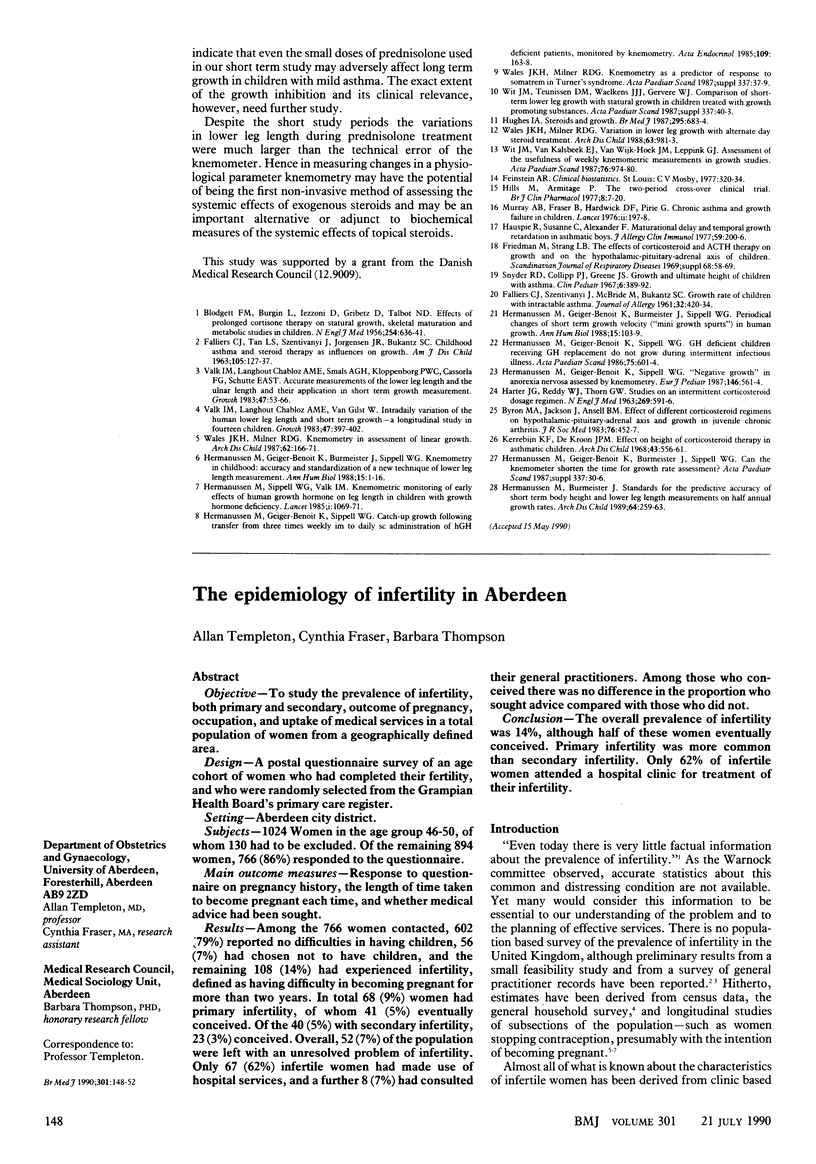
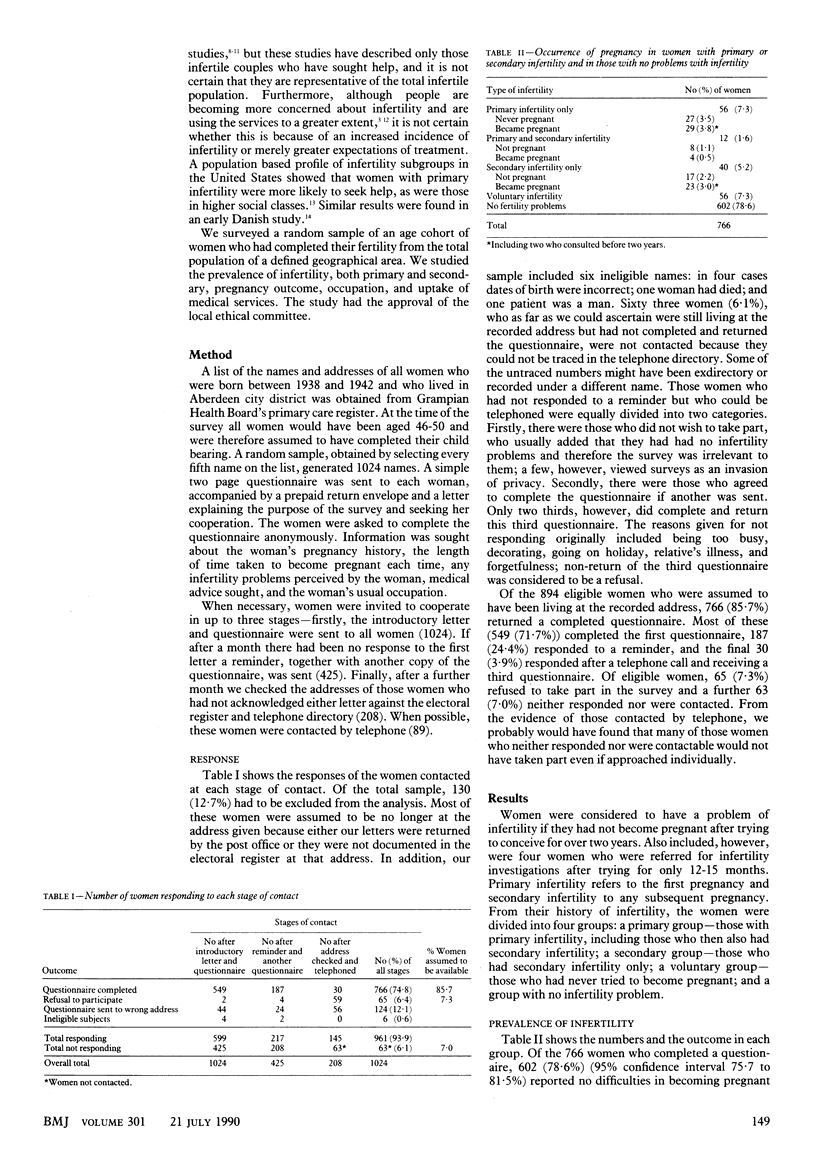
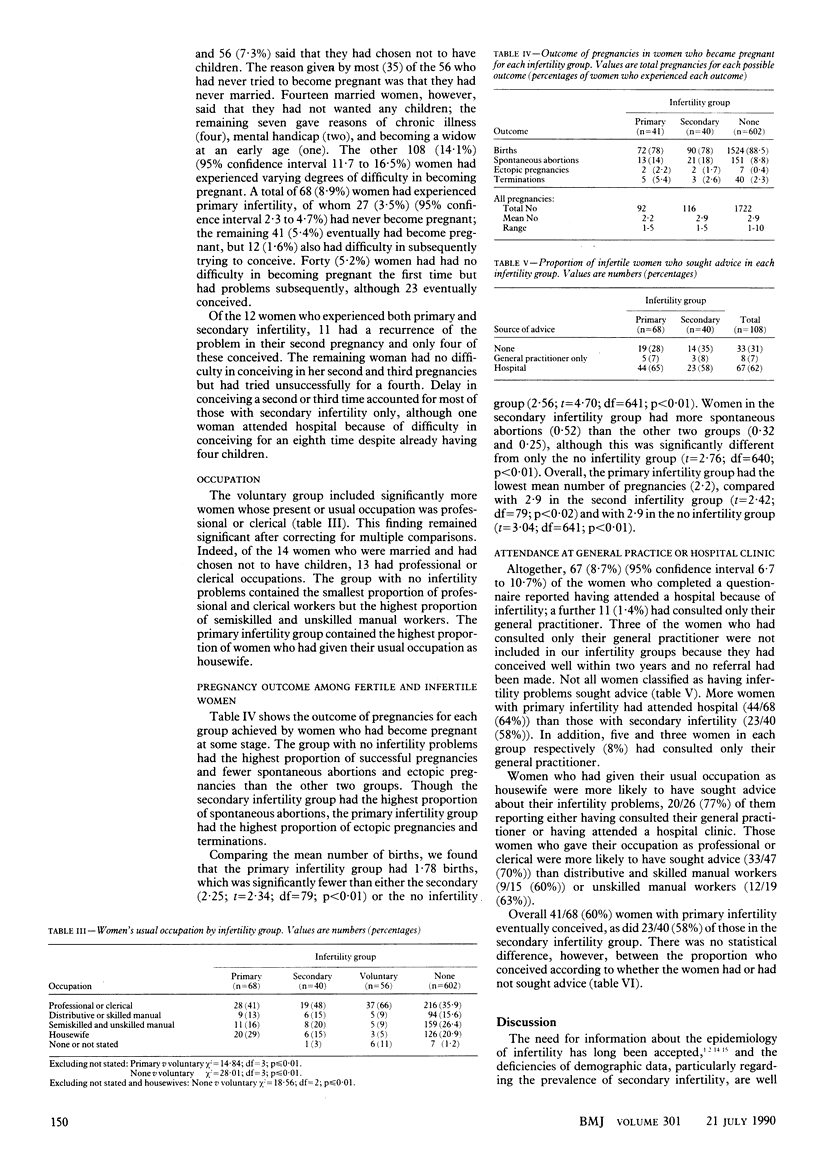
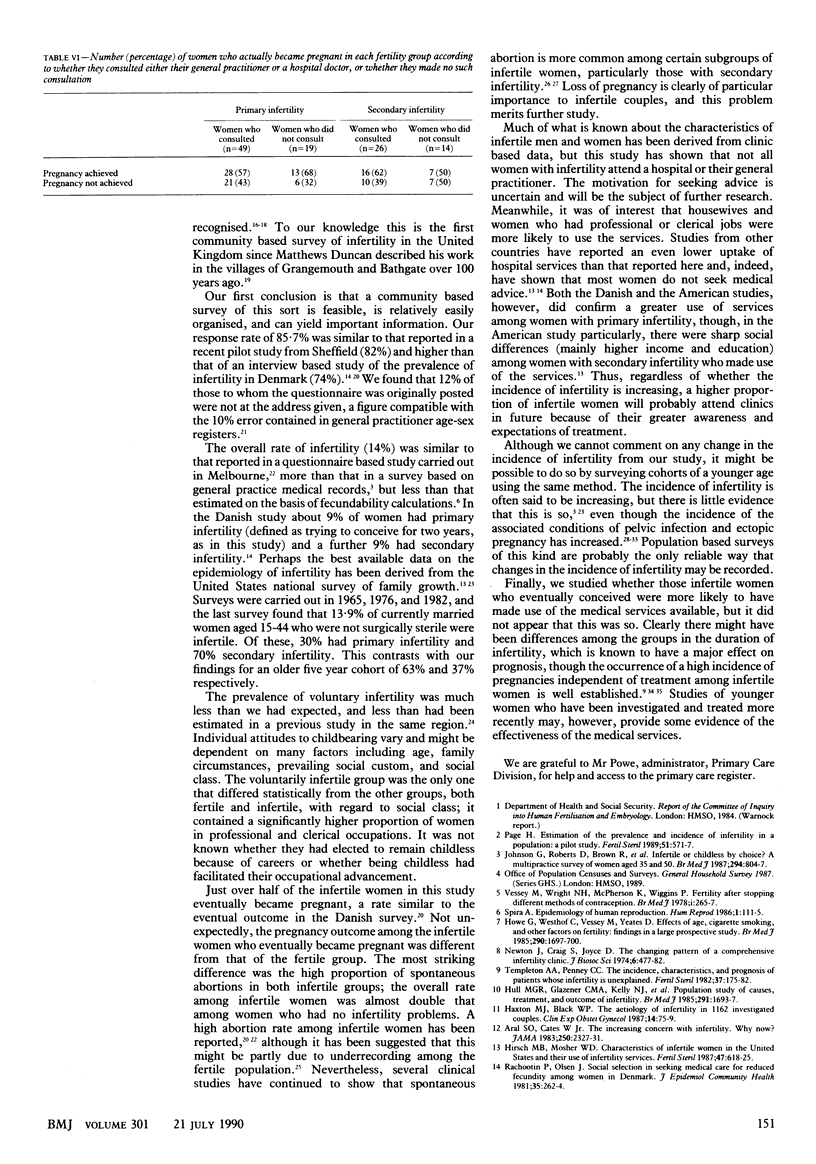
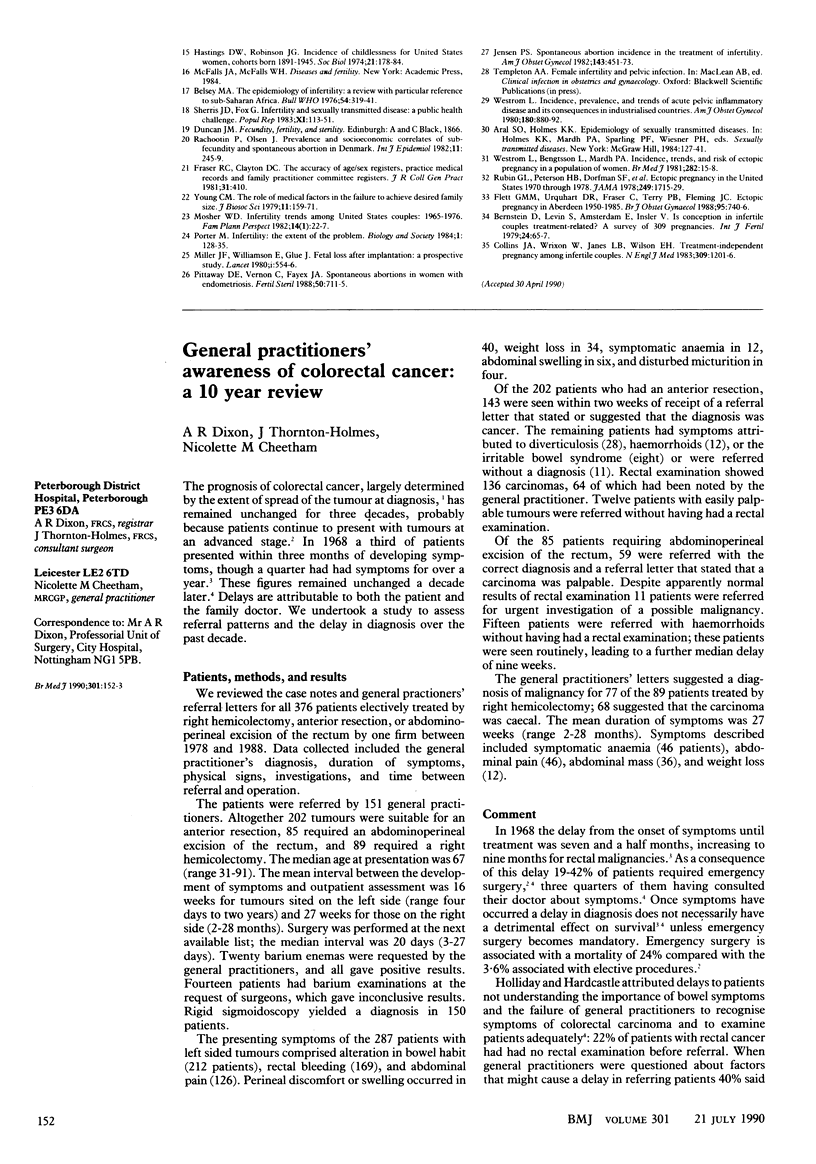
Selected References
These references are in PubMed. This may not be the complete list of references from this article.
- Aral S. O., Cates W., Jr The increasing concern with infertility. Why now? JAMA. 1983 Nov 4;250(17):2327–2331. [PubMed] [Google Scholar]
- Belsey M. A. The epidemiology of infertility: a review with particular reference to sub-Saharan Africa. Bull World Health Organ. 1976;54(3):319–341. [PMC free article] [PubMed] [Google Scholar]
- Bernstein D., Levin S., Amsterdam E., Insler V. Is conception in infertile couples treatment-related? A survey of 309 pregnancies. Int J Fertil. 1979;24(1):65–67. [PubMed] [Google Scholar]
- Collins J. A., Wrixon W., Janes L. B., Wilson E. H. Treatment-independent pregnancy among infertile couples. N Engl J Med. 1983 Nov 17;309(20):1201–1206. doi: 10.1056/NEJM198311173092001. [DOI] [PubMed] [Google Scholar]
- Flett G. M., Urquhart D. R., Fraser C., Terry P. B., Fleming J. C. Ectopic pregnancy in Aberdeen 1950-1985. Br J Obstet Gynaecol. 1988 Aug;95(8):740–746. doi: 10.1111/j.1471-0528.1988.tb06546.x. [DOI] [PubMed] [Google Scholar]
- Fraser R. C., Clayton D. G. The accuracy of age-sex registers, practice medical records and family practitioner committee registers. J R Coll Gen Pract. 1981 Jul;31(228):410–419. [PMC free article] [PubMed] [Google Scholar]
- Hastings D. W., Robinson J. G. Incidence of childlessness for United States Women, cohorts born 1891-1945. Soc Biol. 1974 Summer;21(2):178–184. doi: 10.1080/19485565.1974.9988104. [DOI] [PubMed] [Google Scholar]
- Haxton M. J., Black W. P. The aetiology of infertility in 1162 investigated couples. Clin Exp Obstet Gynecol. 1987;14(2):75–79. [PubMed] [Google Scholar]
- Hirsch M. B., Mosher W. D. Characteristics of infertile women in the United States and their use of infertility services. Fertil Steril. 1987 Apr;47(4):618–625. [PubMed] [Google Scholar]
- Howe G., Westhoff C., Vessey M., Yeates D. Effects of age, cigarette smoking, and other factors on fertility: findings in a large prospective study. Br Med J (Clin Res Ed) 1985 Jun 8;290(6483):1697–1700. doi: 10.1136/bmj.290.6483.1697. [DOI] [PMC free article] [PubMed] [Google Scholar]
- Hull M. G., Glazener C. M., Kelly N. J., Conway D. I., Foster P. A., Hinton R. A., Coulson C., Lambert P. A., Watt E. M., Desai K. M. Population study of causes, treatment, and outcome of infertility. Br Med J (Clin Res Ed) 1985 Dec 14;291(6510):1693–1697. doi: 10.1136/bmj.291.6510.1693. [DOI] [PMC free article] [PubMed] [Google Scholar]
- Johnson G., Roberts D., Brown R., Cox E., Evershed Z., Goutam P., Hassan P., Robinson R., Sahdev A., Swan K. Infertile or childless by choice? A multipractice survey of women aged 35 and 50. Br Med J (Clin Res Ed) 1987 Mar 28;294(6575):804–806. doi: 10.1136/bmj.294.6575.804. [DOI] [PMC free article] [PubMed] [Google Scholar]
- Miller J. F., Williamson E., Glue J., Gordon Y. B., Grudzinskas J. G., Sykes A. Fetal loss after implantation. A prospective study. Lancet. 1980 Sep 13;2(8194):554–556. doi: 10.1016/s0140-6736(80)91991-1. [DOI] [PubMed] [Google Scholar]
- Mosher W. D. Infertility trends among U.S. couples: 1965-1976. Fam Plann Perspect. 1982 Jan-Feb;14(1):22–27. [PubMed] [Google Scholar]
- Newton J., Craig S., Joyce D. The changing pattern of a comprehensive infertility clinic. J Biosoc Sci. 1974 Oct;6(4):477–482. doi: 10.1017/s0021932000009901. [DOI] [PubMed] [Google Scholar]
- Page H. Estimation of the prevalence and incidence of infertility in a population: a pilot study. Fertil Steril. 1989 Apr;51(4):571–577. doi: 10.1016/s0015-0282(16)60601-5. [DOI] [PubMed] [Google Scholar]
- Rachootin P., Olsen J. Prevalence and socioeconomic correlates of subfecundity and spontaneous abortion in Denmark. Int J Epidemiol. 1982 Sep;11(3):245–249. doi: 10.1093/ije/11.3.245. [DOI] [PubMed] [Google Scholar]
- Rachootin P., Olsen J. Social selection in seeking medical care for reduced fecundity among women in Denmark. J Epidemiol Community Health. 1981 Dec;35(4):262–264. doi: 10.1136/jech.35.4.262. [DOI] [PMC free article] [PubMed] [Google Scholar]
- Templeton A. A., Penney G. C. The incidence, characteristics, and prognosis of patients whose infertility is unexplained. Fertil Steril. 1982 Feb;37(2):175–182. doi: 10.1016/s0015-0282(16)46035-8. [DOI] [PubMed] [Google Scholar]
- Vessey M. P., Wright N. H., McPherson K., Wiggins P. Fertility after stopping different methods of contraception. Br Med J. 1978 Feb 4;1(6108):265–267. doi: 10.1136/bmj.1.6108.265. [DOI] [PMC free article] [PubMed] [Google Scholar]
- Weström L. Incidence, prevalence, and trends of acute pelvic inflammatory disease and its consequences in industrialized countries. Am J Obstet Gynecol. 1980 Dec 1;138(7 Pt 2):880–892. doi: 10.1016/0002-9378(80)91077-7. [DOI] [PubMed] [Google Scholar]
- Young C. M. The role of medical factors in the failure to achieve desired family size. J Biosoc Sci. 1979 Apr;11(2):159–171. doi: 10.1017/s0021932000012219. [DOI] [PubMed] [Google Scholar]


